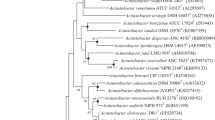Abstract
A novel psychrotolerant, alkalitolerant bacterium, strain Ths, was isolated from a soil sample immersed in hot spring water containing hydrocarbons and grown on a chemically defined medium containing n-tetradecane as the sole carbon source. The isolate grew at 0°C but not at temperatures higher than 45°C; its optimum growth temperature was 27°C. It grew in the pH range of 7–9. The strain utilized C13–C30 n-alkane and fluorene at pH 9 and 4°C. To our knowledge, this is the first report on the bacterium that utilizes a wide range of hydrocarbons at a high pH and a low temperature. Phylogenetic analysis based on 16S rRNA gene sequences showed that strain Ths is closely related to genomic species 6 ATCC 17979 (99.1% similarity), genomic species BJ13/TU14 ATCC 17905 (97.8% similarity), genomic species 9 ATCC 9957 (97.6% similarity) belonging to the genus Acinetobacter and to Acinetobacter calcoaceticus JCM 6842T (97.5% similarity). DNA–DNA hybridization revealed that the isolate has 62, 25, 18 and 19% relatedness, respectively, to genomic species 6 ATCC 17979, genomic species BJ13/TU14 ATCC 17905, genomic species 9 ATCC 9957 and A. calcoaceticus, respectively.

Similar content being viewed by others
References
Baranieck CA, Aislabie J, Foght JM (2002) Characterization of Sphingomonas sp. Ant 17, an aromatic hydrocarbon-degrading bacterium isolated from Antarctic soil. Microb Ecol 43:44–45
Barrow GI, Feltham RKA (1993) Cowan and Steel’s manual for the identification of medical bacteria, 3rd edn edn. Cambridge University Press, London
Bouvet PJM, Grimont PAD (1987) Identification and biotyping of clinical isolates of Acinetobacter. Ann Inst Pasteur Microbiol 138:569–587
Breuil C, Novitsky TJ, Kushner DJ (1975) Characterization of a facultatively psychrophilic Acinetobacter species isolated from river sediment. Can J Microbiol 21:2103–2108
Ezaki T, Hashimoto Y, Yabuuchi E (1989) Fluorometric deoxyribonucleic acid–deoxyribonucleic acid hybridization in micro-dilution wells as an alternative to membrane filter hybridization in which radioisotopes are used to determine genetic relatedness among bacterial strains. Int J Syst Bacteriol 39:224–229
Foght J, Semple K, Gauthier C, Westlake D, Blenkinsopp S, Sergy G, Wang Z, Fingas M (1999) Effect of nitrogen source on biodegradation of crude oil by a defined bacterial consortium incubated under cold, marine conditions. Environ Technol 20:839–849
Gallagher IHC (1971) Occurrence of waxes in Acinetobacter. J Gen Microbiol 68:245–247
Hugh R, Leifson E (1953) The taxonomic significance of fermentative versus oxidative metabolism of carbohydrates by various Gram-negative bacteria. J Bacteriol 66:24–26
Ishige T, Tani A, Sakai Y, Kato N (2000) Long-chain aldehyde dehydrogenase that participates in n-alkane utilization and wax ester synthesis in Acinetobacter sp. strain M-1. Appl Environ Microbiol 66:3481–3486
Kimura M (1980) A simple method for estimating evolutionary rates of base substitutions through comparative studies of nucleotide sequences. J Mol Evol 16:111–120
MacCormack WP, Fraile E (1997) Characterization of a hydrocarbon degrading psychrophilic Antarctic bacterium. Antarct Sci 9:150–155
Margesin R, Schinner F (1997a) Bioremediation of diesel-oil-contaminated alpine soils at low temperatures. Appl Microbiol Biotechnol 47:462–468
Margesin R, Schinner F (1997b) Efficiency of indigenous and inoculated cold-adapted soil microorganisms for biodegration of diesel oil in alpine soils. Appl Environ Microbiol 63:2660–2664
Margesin R, Schinner F (1997c) Laboratory bioremediation experiments with soil from a diesel-oil contaminated site—significant role of cold-adapted microorganisms and fertilizer. J Chem Technol Biotechnol 70:92–98
Margesin R, Schinner F (1999) Biogegradation of diesel oil cold-adapted microorganisms in presence of sodium sulfate. Chemosphere 38:3463–3472
Margesin R, Schinner F (2001) Biodegradation and bioremediation of hydrocarbons in extreme environments. Appl Microbiol Biotechnol 56:650–663
Margesin R, Gander S, Zacke G, Gounot AM, Schinner F (2003) Hydrocarbon degradation and enzyme activities of cold-adapted bacteria and yeasts. Extremophiles 7:451–458
Marmur J (1961) A procedure for the isolation of deoxyribonucleic acid from micro-organisms. J Mol Biol 3:208–218
Pratuangdejkul J, Dharmsthiti S (2000) Purification and characterization of lipase from psychrophilic Acinetobacter calcoaceticus LP009. Microbiol Res 155:95–100
Saitou N, Nei M (1987) The neighbor-joining method: a new method for reconstructing phylogenetic trees. Mol Biol Evol 4:406–425
Tamaoka J, Komagata K (1984) Determination of DNA base composition by reversed-phase high-performance liquid chromatography. FEMS Microbiol Lett 25:125–128
Thompson JD, Higgins DG, Gibson TJ (1994) CLUSTAL W: improving the sensitivity of progressive multiple sequence alignment through sequence weighting, position-specific gap penalties and weight matrix choice. Nucleic Acid Res 22:4673–4680
Westlake DWS, Jobson AM, Philippe R, Cook FD (1974) In situ degradation of oil in a soil of the boreal region of the Northwest Territories. Can J Microbiol 24:254–260
Whyte LG, Greer CW, Inniss WE (1996) Assessment of the biodegradation potential of psychrotrophic microorganisms. Can J Microbiol 32:99–106
Whyte LG, Hawari J, Zhou E, Bourbonniére L, Inniss WE, Greer CW (1998) Biodegradation of variable-chain-length alkanes at low temperature by a psychrotrophic Rhodocuccus sp. Appl Environ Microbiol 64:2578–2584
Whyte LG, Slagman SJ, Pietrantonio F, Bourbonniere L, Koval SF, Laurence JR, Inniss WE, Greer CW (1999) Physiological adaptations involved in alkane assimilation at low temperature by Rhodocuccus sp. strain Q15. Appl Environ Microbiol 65:2961–2968
Yumoto I, Yamazaki K, Hishinuma M, Nodasaka Y, Suemori A, Nakajima K, Inoue N, Kawasaki K (2001) Pseudomonas alcaliphila sp. nov., a novel facultatively psychrophilic alkaliphile isolated from seawater. Int J Syst Evol Microbiol 51:349–355
Yumoto I, Nakamura A, Iwata H, Kojima K, Kusumoto K, Nodasaka Y, Matsuyama H (2002) Dietzia psychralcaliphila sp. nov., a novel, facultatively psychrophilic alkaliphile that grows on hydrocarbons. Int J Syst Evol Microbiol 52:85–90
Acknowledgments
The authors thank Dr. A. Nemec for providing A. parvus NIPH 384T and A. ursingii NIPH 137T.
Author information
Authors and Affiliations
Corresponding author
Additional information
Communicated by L. Huang.
Rights and permissions
About this article
Cite this article
Yamahira, K., Hirota, K., Nakajima, K. et al. Acinetobacter sp. strain Ths, a novel psychrotolerant and alkalitolerant bacterium that utilizes hydrocarbon. Extremophiles 12, 729–734 (2008). https://doi.org/10.1007/s00792-008-0180-8
Received:
Accepted:
Published:
Issue Date:
DOI: https://doi.org/10.1007/s00792-008-0180-8




